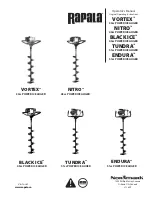
For European regulations:
10. HOW TO SELECT AN
ANCHOR POINT
According to EN 795, the anchor point
(anchor device) for personal protective
equipment against falls from a height must
be able to withstand a force of 12 kN and
meet the requirements specified in the
user’s guide of the fall protection system
used. The anchor point should always be
located above the user.
The connection between the harness
and anchor point must be suitable for the
standard covering the respective type of
use and must have been certified to it.
• Fall arrest system (e.g., energy absorb-
er to EN 355, guided type fall arresters
to EN 353-1/2, retractable type fall
arresters to EN 360)
• Restraint system (e.g., lanyards to EN
354 or EN 358)
• Work positioning system (e.g., lanyards
to EN 354 or EN 358)
• Rope access system (e.g., rope adjust-
ment device to EN 1284 1, rope to EN
1891)
It is crucial to safety to select the position
of the anchor point and the way how the
work is done such that
the free fall and the
height of a fall are restricted to a minimum
.
It is crucial to safety to ensure prior to
any work assignment that there is enough
free space at the work site under the user
(prevention of an impact on the ground or
on an obstacle).
10.1. SUSPENSION TRAUMA
(HARNESS HANG SYNDROME)
Remaining suspended motionless in a
harness for longer periods of time (e.g.,
after having fainted) may cause one’s
blood circulation to be restricted and
consequently lead to a so-called “sus-
pension trauma”. MORTAL DANGER!
Make an EMERGENCY CALL immedi-
ately!
Possible signs of a suspension trauma
are pallor, sweating, shortness of breath,
impaired vision, dizziness, nausea. (in-
complete list, symptoms may vary greatly
from one person to another). Therefore,
affected persons should, if he/she is still
able to do that, take suitable self-help
measures in order to prevent blood con-
gestion in the legs (e.g., by moving the
legs or taking the load off the leg loops,
e.g. by putting the feet in foot loops).
If this is not possible, it will be crucial to
rescue the person from the suspended
position as fast as possible and provide
the necessary emergency medical care.
CAUTION!
DO NOT PLACE THE PERSON IN A
SUPINE OR SHOCK POSITION IMMEDI-
ATELY -> MORTAL DANGER!
Place the accident victim either in a
sitting or a squatting position or, if the
person is unconscious, in a stable side
position, if possible with the upper body
elevated (avoidance of heart failure due
to overly fast reflow of blood from the
lower half of the body).
11
HoW to select an ancHorPoInt
Содержание bMOTION light
Страница 18: ...18 DECLARATIONOFCONFORMITY...
Страница 82: ...82 NOTES...
Страница 83: ...83 NOTES...












































